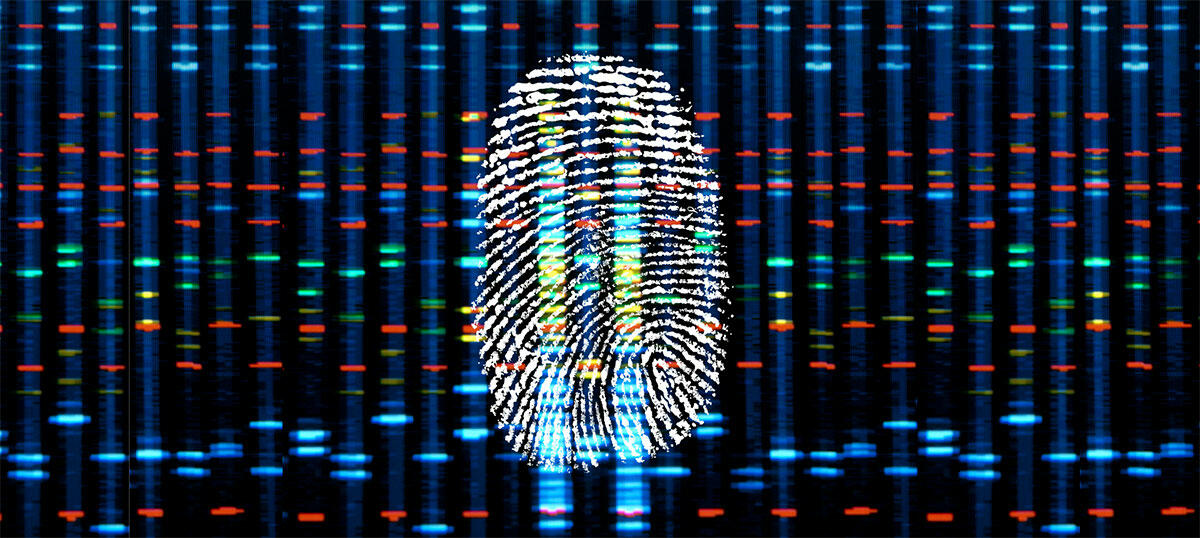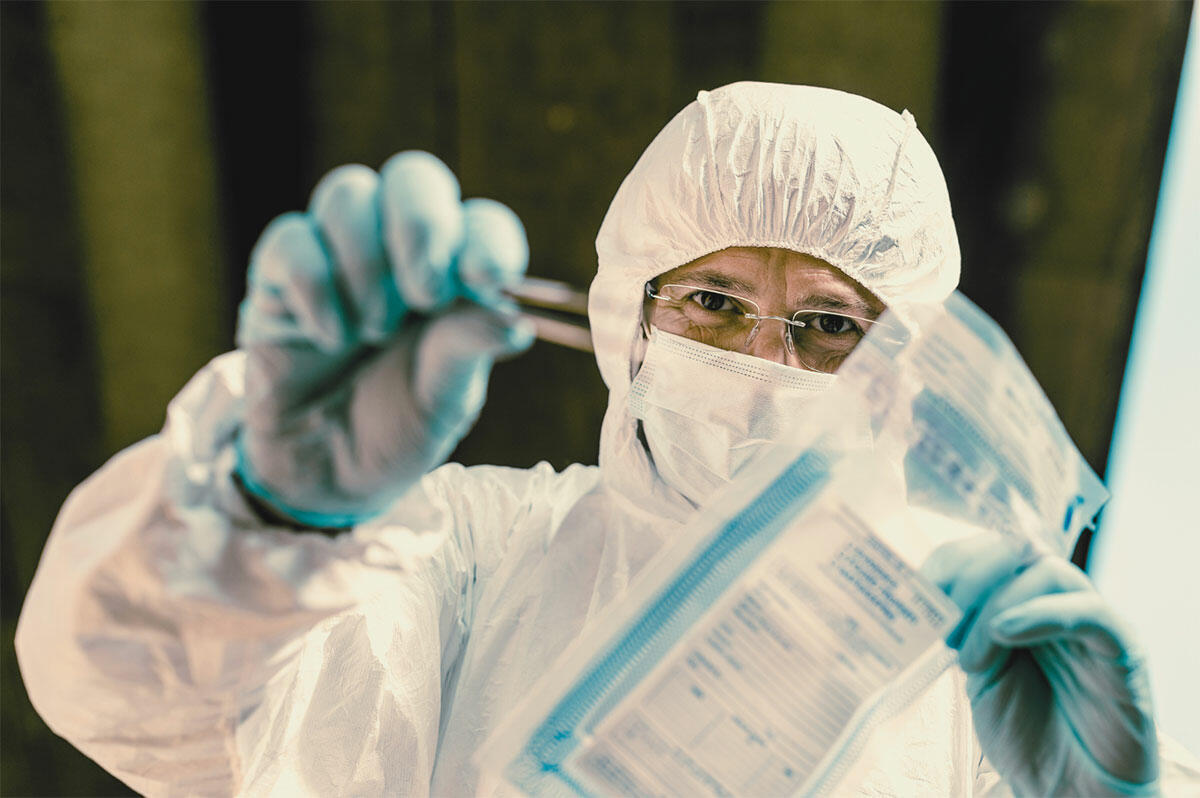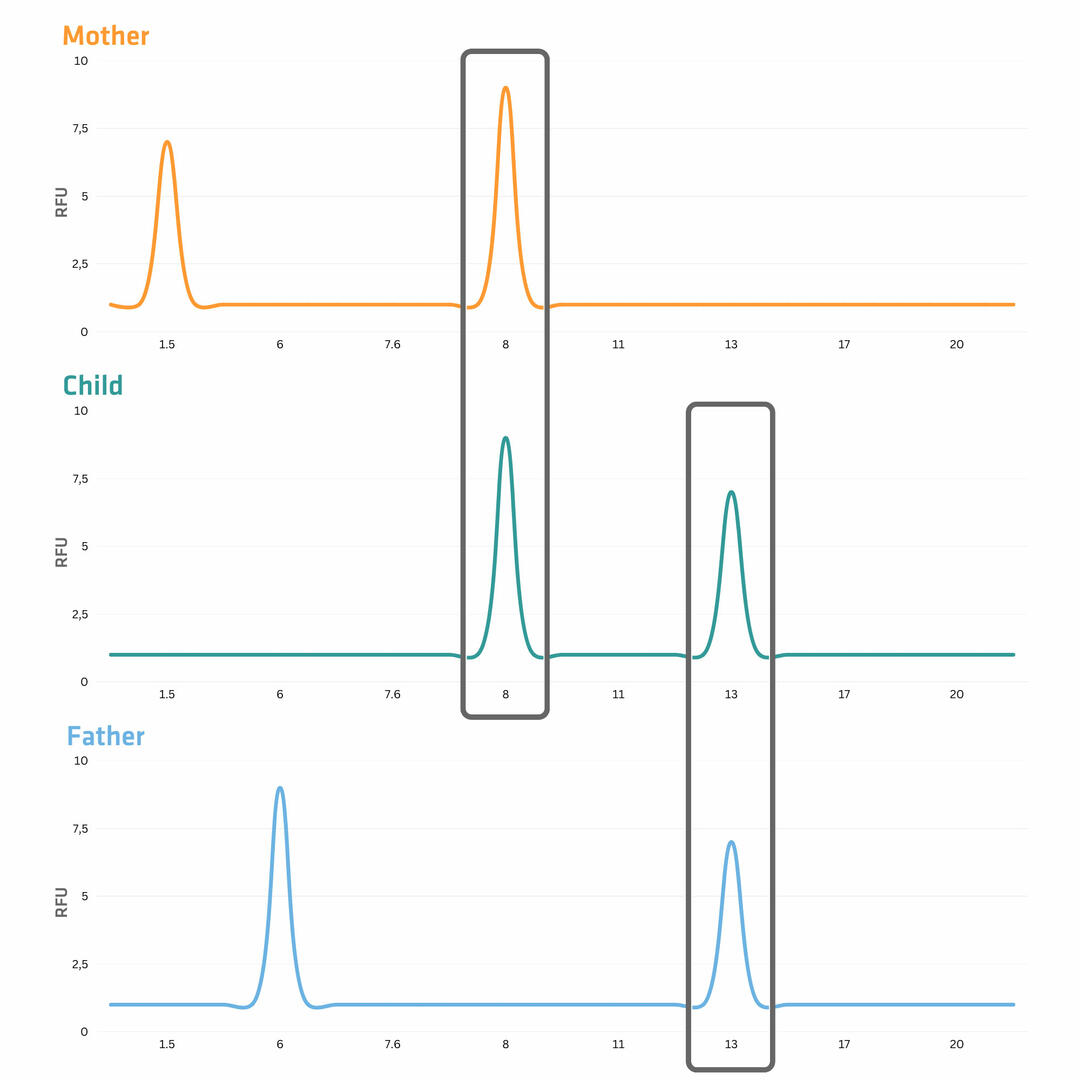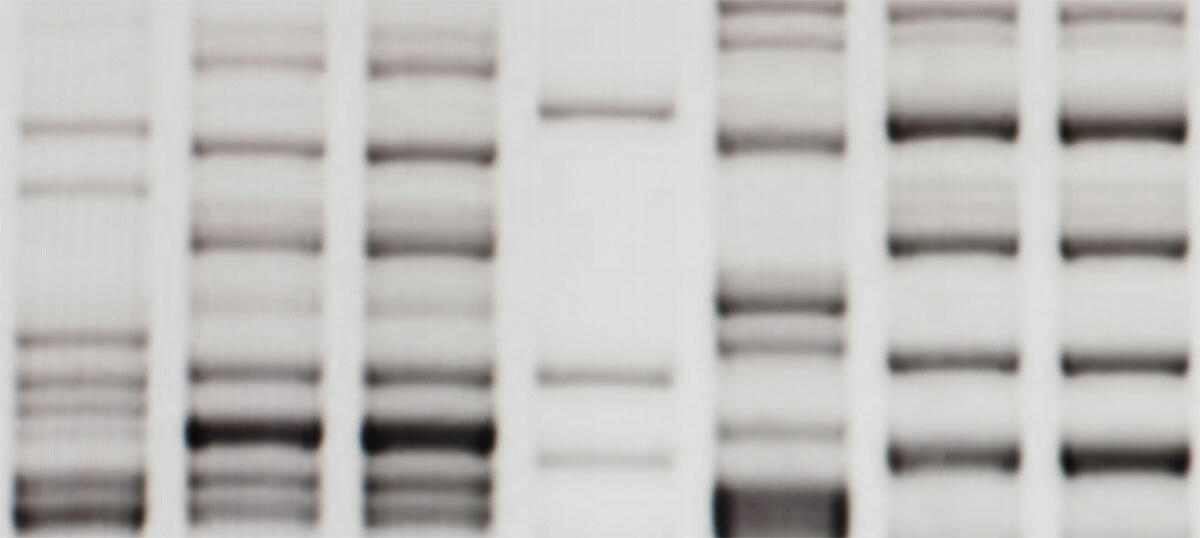DNA fingerprinting: a powerful tool in forensics and beyond
Written by Anina Werner
22. September 2023
In the same way that the ridges on our fingertips or the patterns in our irises differ, there are regions in our DNA that are unique. This individuality is the basis for DNA fingerprinting, a laboratory technique that plays an important role in forensics, medicine and other scientific fields. In this blog, we take an in-depth look at this approach, delving into the steps involved, as well as its applications and limitations.
Table of contents
What is DNA fingerprinting?
DNA fingerprinting – often referred to as DNA profiling, molecular typing or molecular fingerprinting – is a scientific method used to determine an organism's genetic make-up and, if relevant, to compare it to that of others. When applying the technique to the human genome, polymorphic regions are analyzed. While more than 99 % of the human genome is identical across all individuals,1 polymorphic regions vary significantly, and can therefore be used to establish a DNA profile that is almost unique to a person.2
The keyword here is 'almost' – because monozygotic twins, who come from a single fertilized egg, are an exception. They share DNA profiles so similar that they are indistinguishable by DNA fingerprinting. However, it's worth noting that even monozygotic twins don't share 100 % of their genome. Recent studies suggest that an average of 5.2 mutations occur early in their development,3 leading to minor differences in their DNA profiles.

A rare phenomenon called chimerism can also present a challenge to DNA fingerprinting efforts. Chimeras are individuals that contain 2 different types of DNA, and have more than one genetic fingerprint. The case of Lydia Fairchild – who was at risk of losing custody of her children in 2003 due to a DNA test that concluded she was not the biological mother – provides an extraordinary example. The reason? The DNA in Lydia's blood differed to that in the rest of her body, a result of her unborn twin sister's cells fusing with her own in the womb.4
Uses of DNA fingerprinting
DNA fingerprinting is commonly used in forensics, a field that applies science in a legal setting. For example, investigators often collect DNA – in the form of blood, hair, semen, saliva or tissue samples – from crime scenes. These samples are then analyzed, and the resulting DNA profiles can be compared with the genetic fingerprints of suspects to find matches, helping to convict the guilty and to exonerate the wrongly accused. Paternity investigations often rely on DNA fingerprinting as well. Here, the technique is used to compare the child's DNA with the alleged father's DNA. Additionally, in situations such as natural disasters, DNA fingerprinting can be applied to teeth or bones to help identify the victims.
Beyond its use in forensics, DNA fingerprinting has found applications in multiple other sectors, including diagnostics, medical research, ecology, microbiology and genealogy. This article will focus on the technique's applications in forensics, but we would briefly like to mention that it can also be used to:
- track the inheritance of diseases;
- understand genetic disorders;
- develop more effective and personalized treatments for patients;
- characterize the variety of microorganisms in an environmental sample;
- investigate foodborne outbreaks and pinpoint their source;
- determine evolutionary relationships between organisms.
Moreover, genealogists use DNA fingerprinting to trace lineages and establish familial connections. This has opened up new ways for people to explore their ancestry and understand their heritage.

The DNA fingerprinting process
While DNA fingerprinting relies on variations in the genome to generate an individual's DNA profile, not all polymorphic regions are examined during this technique. Instead, only certain sequences are analyzed. For example, the short tandem repeat (STR) approach – commonly used in forensics – focuses on specific loci that contain sequences of 2 to 6 base pairs that are repeated multiple times.5 Since the number of repeats is highly variable among individuals, and since every individual has 2 alleles of each loci – one inherited from the mother and one from the father – they provide an ideal basis for DNA fingerprinting. However, the specific method used for STR analysis varies from country to country; 20 so-called 'CODIS core loci' are routinely used by the US FBI to create a fingerprint,6 while the UK relies on 16 loci plus a gender identifier.7
The process of performing STR analysis is described step-by-step in the section below. For information on other DNA fingerprinting techniques, please refer to the 'Types of forensic DNA analysis' section later in this article.
Step 1: sample collection
A wide variety of samples – including blood, saliva, semen, genital or rectal swabs, skin or tissue cells, fingernails, hairs and urine – can be collected from crime scenes and used for STR analysis. Blood, oral swabs and plucked hairs are the most common sample types obtained from suspects or individuals involved in paternity investigations or other genetic relationship inquiries.8 It is important that correct aseptic sample collection techniques are followed to ensure reliable results.

Step 2: DNA extraction
Once the sample reaches the lab, the next step is to extract DNA from the cells. This process includes cell lysis, inactivation of nucleases, and purification to separate the DNA from cellular debris. Several different methods – each with its own pros and cons – can be used for DNA extraction, and an overview of the different techniques can be found in our blog entitled 'Comparison of RNA and DNA extraction methods'.
Step 3: DNA amplification
To ensure that there is sufficient DNA for downstream analysis, the STR sequences are amplified using polymerase chain reaction (PCR) methods. However, to be able to effectively differentiate and identify the various STR sequences during the subsequent analysis step, the standard PCR protocol has to be modified. When performing a PCR workflow for STR amplification, you not only require a specific primer pair for each locus, but the primers also need to attach a unique fluorescent tag to the resulting PCR products.2
Step 4: DNA analysis
After amplification, the DNA sample is run through a capillary containing a gel that allows smaller STR sequences to travel faster through its pores. At the end of the capillary, a laser beam and a detector register the fluorescent tag of each sequence. The combination of the travel time and the fluorescent signal allow the capillary gel electrophoresis system to determine the length of the STR sequences for each locus analyzed.
Next generation sequencing (NGS) techniques are also used for DNA analysis, and offer several advantages over traditional capillary gel electrophoresis methods. For example, NGS can be used to distinguish between STRs of the same length, but containing different base pair sequences, and offers better handling of degraded DNA samples.9 However, NGS systems are only cost effective when applied to high numbers of samples,9 so the 2 methods continue to co-exist in DNA fingerprinting.10
Step 5: data comparison and interpretation
The final step in a STR analysis workflow involves comparing the genetic fingerprint obtained with that of another sample. Capillary gel electrophoresis results – electropherograms representing each sample – can easily be compared to determine whether samples match or differ, and this process can be performed manually or automated.
For example, a paternity test will likely include 3 samples – from the child, mother and alleged father – that will be run through the capillary gel electrophoresis system. For each locus of interest, you will therefore generate 3 electropherograms with 2 peaks representing the 2 alleles. Figure 1 depicts a possible result of this test, and shows a maternal allele (number 8) and a paternal allele (number 13) that have been passed to the child at this locus. The alleged father could therefore possibly be the child's biological father, if similar results are observed for the other loci required in the test.

The process of comparing a DNA fingerprint from a crime scene sample with that of 1 or more suspects works in exactly the same way, but the electropherograms would match for both alleles if they came from the same individual. Many countries store genetic fingerprints from previous criminal investigations in DNA databanks, allowing forensic scientists to search for a match even when there are no direct suspects.11,12 In some cases and countries, it is even possible to scan genealogy databanks for suspects or their relatives.13 These databanks allow anyone to register and submit a DNA sample through an at-home testing kit and, while their main purpose is to give people more information on their genetic background, they have proven useful in certain criminal investigations.
Concerns and limitations
While DNA fingerprinting is a fascinating technique, and has helped to solve countless crimes, there are concerns and limitations associated with its use. This chapter will discuss some of the key challenges regarding the analysis of genetic material for legal purposes, including ethical reservations, probability considerations and the interpretation of samples containing DNA mixtures.
Ethical concerns
DNA databanks storing the DNA fingerprints of convicted criminals – and, in some cases, even innocent individuals – have sparked ethical debates. Critics argue that such practices violate the right to privacy, especially when the DNA profiles of suspects who are found innocent during the course of an investigation continue to be stored indefinitely.13,14

In addition to concerns about individual rights, there is the potential that these databanks could strengthen racial stereotypes. If racial bias results in more frequent arrests of individuals from certain ethnic groups, their overrepresentation in the databank could lead to more solved crimes involving members of that group, inadvertently reinforcing this bias.14
Ethical discussions around the use of DNA databanks in forensics have been further complicated by the emergence of commercial genealogy databanks. Questions have been raised about whether these databanks should be permitted for use in criminal investigations, and about the extent to which these companies need to disclose the potential use of their customers' genetic data.15,16
Probability
Another important factor to consider in any forensic investigation is probability. While a match between 2 DNA fingerprints indicates a high likelihood that the samples originate from the same individual, it is not absolute proof. Therefore, if 2 DNA samples show the same STR lengths in all the loci analyzed, the population frequency of each STR is used to calculate a random match probability. This probability is typically as low as 1 in several billion, so the chances that 2 individuals share the same STRs across all loci is incredibly low, but it cannot be ruled out. Furthermore, the probability of 2 individuals showing the same genetic fingerprint increases significantly among relatives, especially siblings.14
DNA mixtures
PCR has helped to make DNA fingerprinting an extremely sensitive technique, allowing minuscule quantities of DNA – such as that left on the handle of a knife at a crime scene – to be detected. However, this increased sensitivity also means that samples have become more complex to analyze. Surfaces often contain mixtures of DNA from several individuals, making data interpretation a challenging process. Probabilistic genotyping software – which uses statistical and biological models to determine the likelihood that a certain individual contributed to a mixed DNA sample – can aid these analyses, but these tools are not without their challenges. Disparities in the software used, its configuration, and the underlying analytical models can cause separate labs to come to different conclusions, even when analyzing the exact same evidence.17
Types of forensic DNA analysis
Forensic DNA analysis has come a long way since its early beginnings in the 1980s, with the emergence of several different techniques. STR analysis is now the primary method18 but, before its invention, restriction fragment length polymorphism (RFLP) was the dominant technique. Additionally, since the adoption of STR approaches, other methods such as Y chromosome analysis, mitochondrial DNA (mtDNA) analysis, single nucleotide polymorphism (SNP) typing and mini STR analysis have also been developed. This chapter explores the evolution of forensic DNA analysis techniques, and explains when to use which alternative to STR typing.
Restriction fragment length polymorphism
RFLP analysis begins with the extraction of DNA from a sample. Restriction enzymes are then used to cut this DNA into thousands of pieces, creating fragments that vary in length due to polymorphic regions. Next, these fragments are separated by size through gel electrophoresis and transferred to a membrane.19
Following denaturation, the membrane is incubated with radioactive probes binding to minisatellite regions in the DNA fragments.19 Minisatellites are similar to STRs – in that they are short, repetitive, non-coding DNA sequences – but they are longer, containing 10 to 60 base pairs.20 After incubation, the probes are visualized by exposing the membrane to X-ray film, producing a pattern of bands – the DNA fingerprint.19

Despite its early success, RFLP has been largely replaced by STR approaches that leverage PCR to enable minute amounts of DNA and partially degraded samples to be analyzed.19 There are, however, variations of RFLP that combine the technique with PCR and are still used today. An example is terminal RFLP (T-RFLP), a popular approach in environmental microbiology studies to characterize microbial communities.21 It involves the following steps:22
- sample collection;
- DNA extraction;
- PCR amplification, with primers attaching a fluorescent tag to the amplicons;
- amplicon digestion by restriction enzymes;
- size separation and data analysis using capillary gel electrophoresis;
- data interpretation.
Y chromosome analysis
While STR analysis is used to study specific loci on various chromosomes, Y chromosome analysis examines STR markers found exclusively on the Y chromosome. This technique is particularly valuable when investigating male-on-female sexual assaults – where minuscule amounts of male DNA need to be detected in female samples – or determining familial relationships among males.23,24
Mitochondrial DNA analysis
mtDNA analysis can be more effective than STR approaches when samples contain a low nuclear DNA content. This can be the case when samples consist of old bones, teeth or hair shafts. Instead of examining DNA extracted from the nucleus of cells, this technique analyzes DNA found in mitochondria. As all maternal relatives share identical mtDNA, this method can also be used to analyze unidentifiable remains by comparing them to maternal relatives.24
Single nucleotide polymorphism typing
SNPs are variations in single base positions in the DNA, and represent the most common type of genetic mutation. The template size for SNP typing can be as short as 50 base pairs – compared to the requirement of 300 base pairs for STR analysis – so this technique is particularly useful for analyzing degraded samples. For instance, SNP typing was instrumental in identifying victims of the World Trade Center disaster.25
Mini STR analysis
Mini STR analysis is also designed to handle degraded samples. It attempts to recover information from these samples by reducing the size of the PCR products needed for STR sequence analysis. This is achieved by moving the primers as close as possible to the region of interest.26
Conclusion
DNA fingerprinting has come a long way since its discovery in the 1980s. Although it is mainly used in forensics, its potential is far reaching, with applications ranging from exploring our genetic heritage to advancing personalized medicine. However, like any technology, it poses several challenges, including ethical concerns around the use of DNA databases for forensic purposes. We hope that this blog has enhanced your understanding of how DNA fingerprinting works, and the various techniques available, while demonstrating the importance of valuing both discovery and privacy during forensic investigations.
Did you like this article? Subscribe to our blog for more:



























